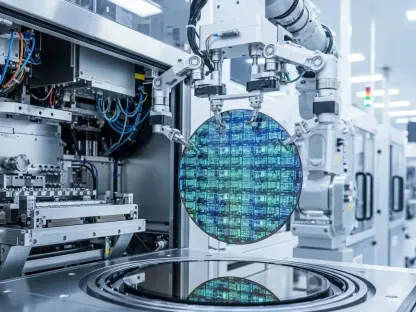High-performance computing (HPC) has long been dominated by companies that invest heavily in skilled programmers to develop optimized code for artificial intelligence systems and other high-stakes applications. For years, industry leaders like NVIDIA have set the gold standard, creating HPC libraries that are difficult for competitors to rival. However, a groundbreaking development from MIT’s Computer Science and Artificial Intelligence Laboratory (CSAIL) promises to revolutionize this heavily monopolized field. This new programming language, Exo 2, aims to democratize the process of generating optimized code, making high-performance computing accessible to a wider audience with fewer resources.
The Introduction of Exo 2
Exo 2 is a novel programming language that provides a user-schedulable interface, allowing programmers to write schedules that guide a compiler in generating highly efficient code. Unlike conventional languages which depend on compilers to automatically produce optimized output, Exo 2 places the power directly in the hands of the programmer. At its core, this user-schedulable language (USL) challenges the established norms of performance engineering. The language was devised to make the complex process of performance optimization more manageable, effectively lowering the entry barrier for less experienced programmers and even students.
A significant advantage of Exo 2 is its ability to enable users with less experience to create competitive HPC libraries swiftly and efficiently. Traditional methods often demand extensive expertise and substantial resources, but Exo 2 simplifies this process dramatically. This democratizing effect is poised to shift the landscape of performance engineering, allowing a broader range of individuals to participate meaningfully in high-performance computing projects. With Exo 2, the promise of achieving competitive performance results in a fraction of the time and effort traditionally required can become a reality for many more developers.
Flexibility and Reusability in Exo 2
Flexibility is a cornerstone of Exo 2’s design, distinguishing it from both its predecessor, Exo, and other existing USLs. What sets Exo 2 apart is its ability to allow users to define new scheduling operations outside the compiler’s core. This aspect of its design facilitates the creation of highly reusable scheduling libraries. This reusability not only simplifies the optimization process across various applications but also makes Exo 2 highly adaptable to different performance engineering scenarios. Lead author Yuka Ikarashi highlights that Exo 2 can reduce the total schedule code by a factor of 100, while still delivering performance on par with state-of-the-art implementations across various platforms.
The power and adaptability of Exo 2’s reusable scheduling libraries are particularly evident in machine learning applications, where optimization is critical. By allowing users to create and share these libraries, Exo 2 fosters a collaborative environment where engineers can build upon each other’s work, continually improving performance across different systems. This approach contrasts sharply with traditional high-performance computing methods that often resulted in highly specialized, non-transferable code. This leap in flexibility marks a significant advancement, opening doors to new applications and efficiency gains in HPC.
Bottom-Up Approach to Automation
Exo 2 employs a bottom-up approach to automation, a strategy focused on empowering performance engineers and hardware implementers to develop their own scheduling libraries. Unlike methods that heavily rely on machine learning or artificial intelligence, Exo 2’s approach allows engineers to tailor optimization techniques specifically for the hardware they are targeting. This ensures that performance is maximized without the unpredictable elements associated with AI-driven optimizations. This bottom-up strategy not only bolsters reliability but also provides engineers with a deeper understanding of how optimizations impact performance on particular hardware.
In a vivid demonstration of this approach’s effectiveness, researchers developed a scheduling library in Exo 2 comprising around 2,000 lines of code. This library efficiently encapsulated optimizations across various hardware accelerators. Their examples included over 80 high-performance kernels, each requiring as few as a dozen lines of code, achieving performance levels on par with or even exceeding those of established libraries like MKL, OpenBLAS, BLIS, and Halide. Such results exemplify the tremendous potential of Exo 2, underscoring how its bottom-up focus can streamline optimization processes and bring powerful capabilities to a broader range of users.
The “Cursors” Mechanism
One of the standout features of Exo 2 is its “Cursors” mechanism, a novel approach to maintaining stability throughout the scheduling process. Cursors provide a stable reference, ensuring that scheduling code remains unaffected by transformations in the object code. This stability is critical as it allows users to encapsulate schedules within library functions securely. The creation and implementation of schedules become manageable and efficient without the constant need to adjust for underlying changes in the object code. This innovation makes it easier to develop and maintain scheduling libraries, ultimately enabling more extensive and complex optimization projects.
The emphasis on user-extensibility in Exo 2, demonstrated through the Cursors mechanism, supports the development of diverse optimization libraries. These libraries serve as foundational tools that other engineers and programmers can leverage for various projects. This user-extensibility allows for ongoing evolution and improvement, cementing Exo 2’s role in the advancement of performance engineering. Through community collaboration and contributions, Exo 2 can continually adapt to new challenges and requirements in high-performance computing, broadening its impact and fostering an ecosystem of shared advancements.
Future Developments and Broader Applications
For many years, high-performance computing (HPC) has been a realm dominated by corporations investing heavily in skilled programmers to create optimized code for artificial intelligence and other critical applications. Industry giants like NVIDIA have established themselves as the benchmark, developing HPC libraries that are challenging for competitors to surpass. However, a revolutionary breakthrough from MIT’s Computer Science and Artificial Intelligence Laboratory (CSAIL) promises to transform this monopolized industry. CSAIL’s new programming language, Exo 2, seems poised to democratize the coding process, generating optimized code with far fewer resources. This development could make high-performance computing more accessible to a broader audience, removing the necessity for vast investments in expert programmers and extensive resources. By leveraging Exo 2, organizations with limited budgets and manpower can potentially achieve efficiencies akin to those enjoyed by industry leaders, heralding a new era of inclusivity in the high-tech world.









